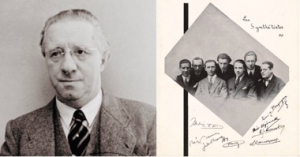#209– July 24, 2023

Jules Strens and The Synthetists
Allegro Vivo
https://www.youtube.com/watch?v=W4GmX_sKoyk
Var.I – Moderato Grazioso
https://www.youtube.com/watch?v=23vVbFcllNg
Var. II – Vivace
https://www.youtube.com/watch?v=4naBemZmaTg
Var. III – Très moderé
https://www.youtube.com/watch?v=y89MoTXv5mw
Vari. IV – Moderato
https://www.youtube.com/watch?v=UV0dmyDXBZo
Var.V – Molto largo e solennel – Finale. Allegro gaio
https://www.youtube.com/watch?v=MCFXpeKFH80
Gil Blas, Symphonic Variations Op. 21, by Belgian composer, conductor, violinist, and organist Jules Strens is our Composition of the Week.
During the coming summer weeks, we are presenting Belgian literature for wind orchestra by Paul Gilson and a group of his students who, in September 1925, joined their creative forces to form the first group of composers in Belgian history, called the Synthetists.
The music they produced constitutes an unavoidable historical heritage of the early 20th century.
This fresh and imaginative repertoire, of great artistic quality, remains curiously and unjustly unknown.
Jules Strens is certainly well known for his Danse Funambulesque Op. 12, written in 1925 for chamber orchestra. After meeting Arthur Prevost, the conductor of the famous Musique des Guides, he would re-score the Danse for full band in 1929. About this work, Tim Reynish eloquently says:
“The opening Andante with evocative solos for flute, oboe and clarinet is reminiscent of the music of Maurice Ravel, perhaps especially his song cycle “Scheherazade” though this indolent atmosphere is constantly interrupted by more energetic music which eventually dominates and turns into an increasingly frenetic dance. The scoring is for the usual European lineup of the Belgian Guides or the French Garde Republicaine, with multiple clarinets and, in addition to the normal brass instruments, a team of keyed bugles, alto horns in E-flat, and bombardons in both B-flat and E-flat. The work is in my opinion a worthy companion piece to Florent Schmitt’s Dionysiaques and is quite unjustly neglected.”
Gil Blas, Op. 21, was written in 1921 as a theme and a set of 5 variations and Strens would receive for this work the “Prix des Concert Ysaye” in 1922. He would proceed as he has done with the Danse Fubambulesque and would arrange the work for full band in 1955.
The score has a duration of 15’ and the set of movements are:
Theme (Allegro vivo)
Variation 1, Moderato grazioso
Variation 2, Vivace
Variation 3, Très moderé
Variation 4, Moderato
Variation 5, Molto largo e solennel – Finale. Allegro gaio
Jules Strens studied orchestration with Paul Gilson and violin at the Royal Conservatory in Brussels. In 1926 he became associated with a group of young, progressive composition students known as the Synthetists.
Strens’ career as a professional musician began with his 1922 appointment as principal violinist at the Théâtre Royal de la Monnaie. From 1931 to 1934 he conducted the Association Symphonique de Bruxelles. Later in life he became active as an organist.
As a composer he was self-taught and prolific, sometimes mixing the grotesque with impressionist colors in a style that remained fundamentally romantic. His first compositions were undeniably influenced by Richard Strauss as show his symphonic variations entitled Gil Blas presented here.
The most predominant element in the evolution of his style is the use and study of polyrhythmic.
Other original or transcribed works for winds by Strens worth mentioning are:
- Préludes Lyriques Op. 16 (1927)
- Danse tragique (1938)
- Carnaval d’été Op. 57 (1939)
- Quintette op.34, Wind Quintet, 1943)
- Quartetto Op. 44, Horn Quartet (1950)
- Sur des Airs de Chasse, Op.45, Horn Quartet (1951)
- Rapsodie Polyrythmique (1953)
- Trio Op. 50, for Oboe, Clarinet and Bassoon (1954)


